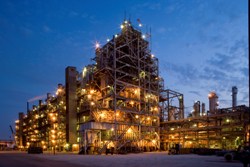US shale gas to sustain chemical industry despite slow manufacturing – ACC
Favorable oil-to-gas price ratios driven by the production of natural gas from shale will drive a renewed US competitiveness that will boost exports and fuel greater domestic investment, economic growth and job creation within the business of chemistry.
This is according to the Year End 2012 Situation and Outlook, published Friday by the American Chemistry Council (ACC) trade group.
 After three years recovering from the recent recession, the global economy stumbled in 2012. The euro area entered a recession again, and a pronounced slowdown in China helped spread economic uncertainty around the world, the ACC said.
After three years recovering from the recent recession, the global economy stumbled in 2012. The euro area entered a recession again, and a pronounced slowdown in China helped spread economic uncertainty around the world, the ACC said.
In the US, although GDP surpassed its pre-recession peak, growth is slow and a typical business cycle expansion has yet to emerge.
Despite this, the business of American chemistry remains a bright spot.
Though rising uncertainty over the fiscal cliff, debt ceiling negotiations and tax reform have hindered business confidence, the most important domestic energy development in the last 50 years is poised to reshape American manufacturing.
Access to vast, new supplies of natural gas from shale deposits creates a competitive advantage for US petrochemical manufacturers. Ethane, a natural gas liquid derived from shale gas, is used as a feedstock by American chemical companies, giving them an advantage over foreign competitors that rely on a more expensive oil-based feedstock.
“Following a decade of high and volatile natural gas prices that destroyed industrial demand and lead to the closure of many gas-intensive manufacturers, shale gas offers a new era of American competitiveness that will lead to greater investment, industry growth, and employment,” said Kevin Swift, ACC’s chief economist and lead author of the report.
The business of chemistry is a $760 billion enterprise and one of America’s most significant manufacturing industries, with more than 96% of all manufactured goods touched by products of chemistry.
For the business of chemistry in the US, the softening of the manufacturing recovery has dampened domestic chemical demand and weakness in Europe and elsewhere has affected export sales. But exports remain a bright spot for the industry.
“Aided by a favorable oil-to-gas ratio, chemical exports grew 1.8% to $191 billion dollars in 2012, helping to turn a trade deficit into a modest surplus,” Swift said. “We’ll see exports continue to grow 4.7% in 2013 and another 6.2% to $209 billion in 2014."
While overall shipments in the business of chemistry slipped 1.5% in 2012, they are expected to increase nearly 9% over the next two years, to $794 billion in 2013 and $833 billion in 2014.
According to Swift, it is not only the chemical industry that stands to benefit from increased access to natural gas from shale. Other natural gas and energy intensive manufacturing industries will also realize renewed competitiveness and increased output, potentially creating 662,000 direct and related jobs and generating $342 billion in economic expansion.
Within the business of chemistry, several end-use markets have already shown signs of growth. At nearly $3,650 of chemistry per vehicle, light vehicles represent an important market for the industry and production continues to improve.
US light vehicle sales are expected to rise in 2013 and 2014 as pent-up demand, improved employment and greater availability of credit foster demand. The slowly recovering US housing market (more than $15,000 of chemistry per start) is also likely to spur demand.






Comments